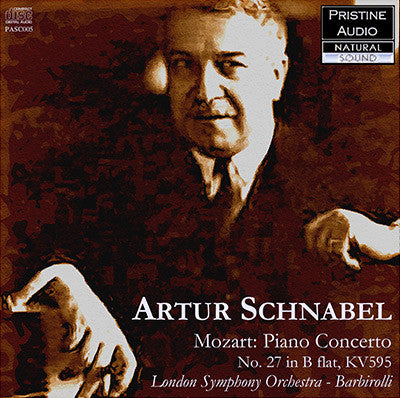
This album is included in the following sets:
This set contains the following albums:
- Producer's Note
- Full Track Listing
- Cover Art
Written in 1791, this was Mozart's final work in a genre he excelled at. The work of a genius at his peak, this is surely one of the greatest Piano Concertos ever written. In the hands of a pianistic genius like Artur Schnabel (right), himself at his peak, it's hard to imagine this recording being anything but excellent, but nothing quite prepared us for how good this was.
Prepare yourself for one of those wonderful moments when you completely forget that you're listening to a recording made over 70 years ago - shut your eyes and let the music carry you away.
MOZART Piano Concerto No. 27 in B flat major, K.595
Artur Schnabel, piano
London Symphony Orchestra,
Conductor: John Barbirolli
Recorded 2nd May, 1934, Abbey Road Studio 1, London.
Transfer and remastering by Andrew Rose, March 2007.
Issued as 4 HMV 78s, D.B.2249-D.B.2252
Duration 31'03"
A listener writes
Schnabel's perfectly shaped phrases exceed that of the otherwise decent orchestral playing
Schnabel is legendary. I learned his name early in my musical studies but have seldom had the occasion to enjoy his playing. Many a piano student has benefitted from his edition of the Beethoven sonatas.
This recording has a startling dynamic range and delicacy to it. The unaccompanied piano phrases, the tails of which are played pianissimo, are quite daring for this old format which was beset with such a limited dynamic capability. This is not a performance governed by calculated cerebriality, but rather there seems to be a sense of a sweet savoring and prolonging of the profound simplicity and purity of this music. Yes, there is generous rubato, including the able accompaniment led by Barbirolli, then in his mid-thirties and about to take on a seven-year role leading the New York Philharmonic. But the greater grace here is from Schnabel, whose perfectly shaped phrases exceed that of the otherwise decent orchestral playing. One wonders if Barbirolli had the advantage of modern session playback, instead of the old direct-to-disc terrors, if he would have shaped the orchestra more. Or, perhaps he found it excessive and was determined to not fully match Schnabel's sensitivities!
Andrew has done a lovely restoration here. These performances don't often get their due because the technology (or lack thereof) gets in the way of the music, either because the discs themselves are such a load of work to handle, or because the noise and lo-fi mono sound is such an adjustment to our modern ears. While anyone demanding DVD-Audio quality for everything they hear need not apply, the rest of us can benefit from Andrew's finely tuned engineering, which minimizes the limitations of the old discs and brings the music nicely forward. No more side changes (nor evidence of them, which is very impressive)! No more pops, crackles, and cracked discs! If you're looking for source "purity," a la Pearl Records' raw and full-ranged noisy disc sound, be warned that these are restorations and not simply transfers. A great deal of surface noise and other "intrusions" have been carefully reduced, and frequency balances no doubt have been carefully refined. Further, I'll give away a dirty secret: there is a subtle amount of short-length ambiance added to this Mozart recording, though by no means is all of the ambiance on it.
This begs the question of whether this kind of process serves the music or creates something derivative. Ultimately that is something for each listener to determine, and thanks to Andrew's generous previews, can be readily answered. For me this functions as a restoration should: not altering the artistic direction of the performance, but delivering it clearly to the listener.

